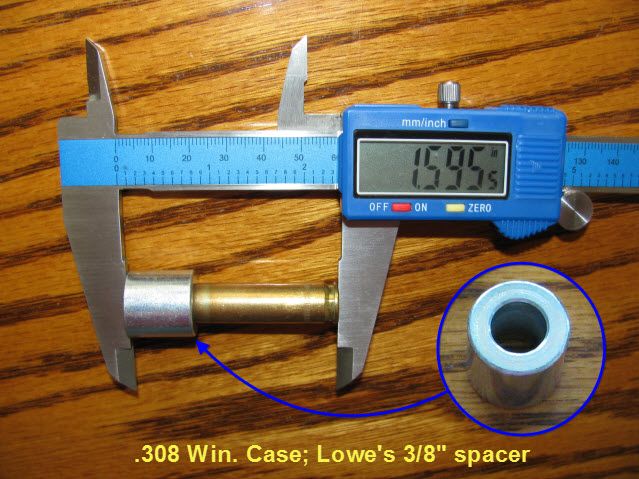Last year I had a Savage 11 rebarreled by AJ Brown, with a Shilen .358 barrel in 358 Hoosier. After some growing pains with the dies and one bad lot of primers I found it to be quite accurate. However it threw its first shot 1.5 inches low before shooting a very tight three inch group every time. Shots 4 and 5 walked upwards way out of the group. The gunsmith offered to look for the problem and Shilen also said they wanted the barrel back as they looked at the targets and said for sure it's group walking and probably needs to have the heat treating re-done as there looked to be some stress remaining in the steel.
Shilen did their work but did not have chamber gauges so sent the whole thing back to me to install the barrel, which I did. Without head space gauges I installed the barrel as follows, which the Shilen rep suggested.
I snugged the barrel onto a spent case fired in the same chamber. Then backed the barrel off 1/8 turn and tightened it down. I noticed the aft trigger guard wood screw (fastens into plastic only and bears no load) is stripped. I packed the hole and snugged it down thinking it's of no consequence. I torqued the action screws to 35# and the scope mount screws to 15 pounds, reinstalling the same scope. Scope has given good service on two rifles before.
Off to the range with the same three best load from before the barrel work.
Sadly, the groups were much worse than before.
Some serious vertical stringing, best load now almost 2MOA and the others almost 4. This time the group is random, not walking up with each shot like before. But only vertical. Good bench set up.
Finally, the question.
Could I have installed the barrel incorrectly? Slightly more or less headspace needed? It seems pretty simple to install in the stock as it just beds against two metal pillars. Stock is synthetic. I used channel locks and a leather strap to tighten the barrel nut as much as I reasonably could. It seems quite tight. Could it need more or less headspace to prevent this vertical stringing? The loads chamber easily and bullets and OAL measure the same to be .020 off the lands. Shoulder position might be a couple thousanths off? Could that cause such a difference? Factory loads are always a tad loose in chambers.
I'm down to about 20 bullets of the best accuacy ones, and Barnes says several more weeks before making more. Time is running out to send it back to the gunsmith or Shilen. Do I sound desperate? I've always been able to get rifles more accurate for 50 years, but this one has some new angle as I've never mounted a barrel before. The Savage looks pretty fool proof, but I'm not shy about learning I've messed up.
I'll replace the scope and try again, but doubt that is the issue.
Thank you for any and all wisdom about installing the barrel or any other likely culprit.
Humbly,
Shilen did their work but did not have chamber gauges so sent the whole thing back to me to install the barrel, which I did. Without head space gauges I installed the barrel as follows, which the Shilen rep suggested.
I snugged the barrel onto a spent case fired in the same chamber. Then backed the barrel off 1/8 turn and tightened it down. I noticed the aft trigger guard wood screw (fastens into plastic only and bears no load) is stripped. I packed the hole and snugged it down thinking it's of no consequence. I torqued the action screws to 35# and the scope mount screws to 15 pounds, reinstalling the same scope. Scope has given good service on two rifles before.
Off to the range with the same three best load from before the barrel work.
Sadly, the groups were much worse than before.
Some serious vertical stringing, best load now almost 2MOA and the others almost 4. This time the group is random, not walking up with each shot like before. But only vertical. Good bench set up.
Finally, the question.
Could I have installed the barrel incorrectly? Slightly more or less headspace needed? It seems pretty simple to install in the stock as it just beds against two metal pillars. Stock is synthetic. I used channel locks and a leather strap to tighten the barrel nut as much as I reasonably could. It seems quite tight. Could it need more or less headspace to prevent this vertical stringing? The loads chamber easily and bullets and OAL measure the same to be .020 off the lands. Shoulder position might be a couple thousanths off? Could that cause such a difference? Factory loads are always a tad loose in chambers.
I'm down to about 20 bullets of the best accuacy ones, and Barnes says several more weeks before making more. Time is running out to send it back to the gunsmith or Shilen. Do I sound desperate? I've always been able to get rifles more accurate for 50 years, but this one has some new angle as I've never mounted a barrel before. The Savage looks pretty fool proof, but I'm not shy about learning I've messed up.
I'll replace the scope and try again, but doubt that is the issue.
Thank you for any and all wisdom about installing the barrel or any other likely culprit.
Humbly,

